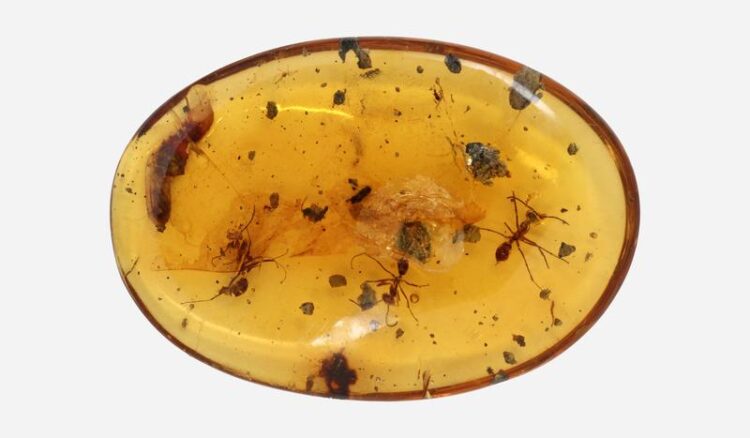Division of labour in ants goes back over 100 million years

Fossils of female ants and a pupa enclosed in Cretaceous amber.
Photo: Shûhei Yamamoto
University of Jena biologists discover in fossils earliest proof of cooperative behaviour in ants.
An international research team led by biologists from Friedrich Schiller University Jena has discovered material evidence that ants already lived in a special social system based on the division of labour more than 100 million years ago. Ants live in states organised according to the division of tasks. There are three castes, each of which has a different role: the queen lays eggs and the males fertilise them, while the workers look after the offspring and deal with finding food and nest-building. In biology, this special behaviour is called eusociality, which is developed in a particularly complex way in ants, as it is shown not only in their behaviour, but also in their morphology. Winged females take on the role of the queen, while wingless, infertile females perform the tasks of the workers. But when exactly in their evolution did ants start this unique teamwork? The research team has now established that this cooperative way of life developed in the early Cretaceous period and the scientists present their findings in the research journal “Zoological Journal of the Linnean Society”.
Ant pupa found in Cretaceous amber for the first time
In their work, the biologists closely examined four fossils enclosed in amber. These were three adult female wingless ants and one incompletely developed pupa – the first ant pupa ever found in Cretaceous amber. “With the help of micro-computed tomography images, we were able to determine that the soft tissues of the insects have been exceptionally well-preserved,” explains Dr Brendon E. Boudinot, who is currently working at the University of Jena under a Humboldt Research Fellowship. “This enabled us to examine the precise structure of the brain and the transverse muscle fibres, for example, and thus compare the four specimens with each other in fine detail.”
Sensational discoveries
Based on these insights into the ants’ internal anatomy, the researchers were able to draw conclusions about the species – and in doing so to make two spectacular discoveries. First, they established that two of the adult insects belong to a previously unknown species of the extinct ant genus Gerontoformica, which the biologists have now been able to describe more precisely for the first time.
Second, the third adult ant and the pupa are both of the same species: Gerontoformica gracilis. “As ant pupae are not mobile, it can be inferred that the adult insect carried it,” says US entomologist Boudinot. “This brood transport, as it’s called, is a unique feature of ant coexistence based on their division of labour. The fossil therefore provides the first material evidence of cooperative behaviour from the Cretaceous period: these ants looked after their young together, went in search of food together and had different queen and worker castes.” The fossil representatives of the extinct ant genus are therefore an important “missing link” between today’s ants and their closest relatives, confirming that the specialised social system of ants evolved sometime in the early Cretaceous – during the time of the dinosaurs.
New insights into the evolution of ants
The work on the four fossil ants has shown the researchers the wealth of information that can be produced using the high-resolution imaging facilities. “We can now derive new insights into the development of the internal anatomy of fossil insects and clarify much more precisely the relationships of fossil species to each other and to species living today,” says Boudinot. For example, how did the two different female forms of ants – queens and workers – develop? Did the wings regress first and then fertility, did the onset of sterility lead to the loss of the wings or did both developments take place at the same time? Thanks to the new findings and methods, scientists may soon be able to provide answers to such questions about the evolution of ants. There are also new, connected, research questions in the field of sociobiology, for example on the emergence of eusociality.
Wissenschaftliche Ansprechpartner:
Dr Brendon E. Boudinot
Institute of Zoology and Evolutionary Research of the University of Jena
Erbertstraße 1, 07743 Jena, Germany
E-mail: boudinotb@googlemail.com
Originalpublikation:
B. E. Boudinot, , A. Richter, J. Katzke, J. C. M. Chaul, R. A. Keller, E. P. Economo, R. G. Beutel, S. Yamamoto: “Evidence for the evolution of eusociality in stem ants and a systematic revision of †Gerontoformica (Hymenoptera: Formicidae)”, Zoological Journal of the Linnean Society, 2022, https://academic.oup.com/zoolinnean/advance-article/doi/10.1093/zoolinnean/zlab0…
Media Contact
All latest news from the category: Life Sciences and Chemistry
Articles and reports from the Life Sciences and chemistry area deal with applied and basic research into modern biology, chemistry and human medicine.
Valuable information can be found on a range of life sciences fields including bacteriology, biochemistry, bionics, bioinformatics, biophysics, biotechnology, genetics, geobotany, human biology, marine biology, microbiology, molecular biology, cellular biology, zoology, bioinorganic chemistry, microchemistry and environmental chemistry.
Newest articles

Innovative 3D printed scaffolds offer new hope for bone healing
Researchers at the Institute for Bioengineering of Catalonia have developed novel 3D printed PLA-CaP scaffolds that promote blood vessel formation, ensuring better healing and regeneration of bone tissue. Bone is…

The surprising role of gut infection in Alzheimer’s disease
ASU- and Banner Alzheimer’s Institute-led study implicates link between a common virus and the disease, which travels from the gut to the brain and may be a target for antiviral…

Molecular gardening: New enzymes discovered for protein modification pruning
How deubiquitinases USP53 and USP54 cleave long polyubiquitin chains and how the former is linked to liver disease in children. Deubiquitinases (DUBs) are enzymes used by cells to trim protein…



